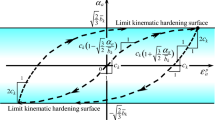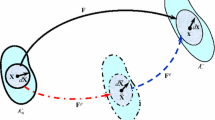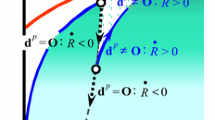Abstract
The hypoelastic-based plastic constitutive model has been developed to describe the wide class of elastoplastic deformation behavior of solids. The physical and mathematical backgrounds of the hypoelastic-based plasticity, i.e. (i) the transformation of the material-time derivative of general scalar-valued tensor function to the corotational-time derivative required for the derivation of the consistency condition fulfilling the objectivity, (ii) the requirement for the derivation of the additive decomposition of the strain rate and the continuum spin into the elastic and the plastic parts from the multiplicative decomposition of the deformation gradient, (iii) the mechanical requirements for elastoplastic constitutive equations, i.e. the continuity and the smoothness conditions and (iv) the derivation of the general loading criterion are deliberated first. Then, the subloading surface model is formulated in the framework of the hypoelastic-based plasticity. It materializes the pertinent descriptions of wide classes of deformations, i.e. the monotonic, the non-proportional and the cyclic loadings, the rate-dependent deformation behavior in a general rate up to the impact load for wide classes of materials, e.g. metals and soils and the friction phenomena between solids and further the deformation behavior of metallic materials within the framework of the crystal plasticity. In addition, it possesses the distinctive advantage in numerical analysis such that the judgment of yielding is not required in the loading criterion and the stress is automatically attracted to the yield surface in the plastic loading process, engendering a high efficiency in numerical calculations.









































Similar content being viewed by others
References
Armstrong PJ, Frederick CO (1966) A mathematical representation of the multiaxial Bauschinger effect. CEGB report RD/B/N 731 (or in Mater High Temp 24:1–26 (2007))
Asaoka A, Nakano M, Noda T (1997) Soil-water coupled behaviour of heavily overconsolidated clay near/at critical state. Soil Found 37(1):13–28
Asaro R, Lubarda V (2006) Mechanics of solids and materials. Cambridge Univ Press, Cambridge
Asaro RJ, Needleman A (1985) Texture development nand strain hardening in rate dependent polycrystals. Acta Metall 33:923–953
Baumberger T, Heslot F, Perrin B (1994) Crossover from creep to inertial motion in friction dynamics. Nature 30:544–546
Belytschko T, Liu WK, Moran B (2000) Nonlinear finite elements for continua and structures. Wiley, New York
Bonet J, Wood RD (1997) Nonlinear continuum mechanics for finite element analysis. Cambridge Univ Press, Cambridge
Bowden FP, Tabor D (1958) The friction and lubrication of solids. Clarendon Press, London
Chaboche JL (1989) Constitutive equations for cyclic plasticity and cyclic viscoplasticity. Int J Plast 5:247–302
Chaboche JL (1991) On some modifications of kinematic hardening to improve the description of ratcheting effects. Int J Plast 7:661–678
Chaboche JL (2008) A review of some plasticity and viscoplasticity constitutive theories. Int J Plast 24:1642–1693
Chaboche JL, Dang-Van K, Cordier G (1979) Modelization of the strain memory effect on the cyclic hardening of 316 stainless steel. In: Trans 5th int conf SMiRT, Berlin. Division L. Paper No. L. 11/3
Chida Y, Yamakawa Y, Hashiguchi K, Ikeda K (2013) Subloading surface Cam-clay model with anisotropic rotational hardening for finite strains based on multiplicative decomposition of plastic deformation gradient tensor. J Appl Mech 16:255–266
Chowdhury EQ, Nakai T, Tawada M, Yamada S (1999) A model for clay using modified stress under various loading conditions with the application of subloading concept. Soils Found 39(6):103–116
Cotter BA, Rivlin RS (1955) Tensors associated with time-dependent stresses. Q Appl Math 13:177–182
Dafalias YF (1984) The plastic spin concept and a simple illustration of its role in finite plastic transformation. Mech Mater 3:223–233
Dafalias YF (1985) A missing link in the macroscopic constitutive formulation of large plastic deformations. In: Sawczuk A, Bianchi G (eds) Plasticity today, Int symp recent trends and results in plasticity. Elsevier, Amsterdam, pp 135–151
Dafalias YF (1985) The plastic spin. J Appl Mech 52:865–871
Dafalias YF (1986) Bounding surface plasticity. I: Mathematical foundation and hypoplasticity. J Eng Mech 112:966–987
Dafalias YF (1998) Plastic spin: necessity or redundancy? Int J Plast 14:909–931
Dafalias YF (2011) Finite elastic-plastic deformations: beyond the plastic spin. Theor Appl Mech 38:321–345
Dafalias YF, Popov EP (1975) A model of nonlinearly hardening materials for complex loading. Acta Mech 23:173–192
Delobelle P, Robinet P, Bocher L (1995) Experimental study and phenomenological modelization of ratchet under uniaxial and biaxial loading on austenitic stainless steel. Int J Plast 11:295–330
Drucker DC (1988) Conventional and unconventional plastic response and representation. ASME Appl Meek Rev 41:151–167
Ellyin F, Xia Z (1989) A rate-independent constitutive model for transient non-proportional loading. J Mech Phys Solids 37:71–91
Ferrero JF, Barrau JJ (1997) Study of dry friction under small displacements and near-zero sliding velocity. Wear 209:322–327
Ghaei A, Green DE (2010) Numerical implementation of Yoshida–Uemori two-surface plasticity model using a fully implicit integration scheme. Comput Mater Sci 48:195–205
Green AE, Naghdi PM (1965) A general theory of an elastic-plastic continuum. Arch Ration Mech Anal 18:251–281
Gurtin ME, Fried E, Anand L (2010) The mechanics and thermodynamics of continua. Cambridge Univ Press, Cambridge
Hashiguchi K (1977) An expression of anisotropy in a plastic constitutive equation of soils. In: Constitutive equations of soils. Proc 9th int conf soil mech found eng, spec ses 9, Tokyo, JSSMFE, pp 302–305
Hashiguchi K (1978) Plastic constitutive equations of granular materials. In: Proc US-Japan seminar on continuum mech stat appr mech granular materials, Sendai, pp 321–329
Hashiguchi K (1980) Constitutive equations of elastoplastic materials with elastic-plastic transition. J Appl Mech 47:266–272
Hashiguchi K (1985) Subloading surface model of plasticity. In: Constitutive laws of soils, Proc discuss ses 1A, 11th int conf soil mech found eng, San Francisco, pp 127–130
Hashiguchi K (1989) Subloading surface model in unconventional plasticity. Int J Solids Struct 25:917–945
Hashiguchi K (1993) Fundamental requirements and formulation of elastoplastic constitutive equations with tangential plasticity. Int J Plast 9:525–549
Hashiguchi K (1993) Mechanical requirements and structures of cyclic plasticity models. Int J Plast 9:721–748
Hashiguchi K (1994) Loading criterion. Int J Plast 8:871–878
Hashiguchi K (1997) The extended flow rule in plasticity. Int J Plast 13:37–58
Hashiguchi K (2000) Fundamentals in constitutive equation: continuity and smoothness conditions and loading criterion. Soil Found 40(3):155–161
Hashiguchi K (2005) Subloading surface model with tangential relaxation. In: Proc int symp plasticity ’05, pp 259–261
Hashiguchi K (2006) Constitutive model of friction with transition from static- to kinetic-friction—time-dependent subloading-friction model. In: Proc int symp plasticity ’06, pp 178–180
Hashiguchi K (2007) General corotational rate tensor and replacement of material-time derivative to corotational derivative of yield function. Comput Model Eng Sci 17:55–62
Hashiguchi K (2007) Extended overstress model for general rate of deformation including impact load. In: Proc 13th int symp plasticity & its current appl, pp 37–39
Hashiguchi K (2013) Elastoplasticity theory, 2nd edn. Springer, Berlin
Hashiguchi K, Chen Z-P (1998) Elastoplastic constitutive equations of soils with the subloading surface and the rotational hardening. Int J Numer Anal Methods Geomech 22:197–227
Hashiguchi K, Mase T (2011) Physical interpretation and quantitative prediction of cyclic mobility by the subloading surface model. Soils Found 6:225–241
Hashiguchi K, Ozaki S (2008) Constitutive equation for friction with transition from static to kinetic friction and recovery of static friction. Int J Plast 24:2102–2124
Hashiguchi K, Protasov A (2004) Localized necking analysis by the subloading surface model with tangential-strain rate and anisotropy. Int J Plast 20:1909–1930
Hashiguchi K, Tsutsumi S (2001) Elastoplastic constitutive equation with tangential stress rate effect. Int J Plast 17:117–145
Hashiguchi K, Tsutsumi S (2003) Shear band formation analysis in soils by the subloading surface model with tangential stress rate effect. Int J Plast 19:1651–1677
Hashiguchi K, Tsutsumi S (2006) Gradient plasticity with the tangential subloading surface model and the prediction of shear band thickness of granular materials. Int J Plast 22:767–797
Hashiguchi k, Yamakawa Y (2012) Introduction to finite strain theory for continuum elasto-plasticity. Wiley series in computational mechanics. Wiley, New York
Hashiguchi K, Yoshimaru T (1995) A generalized formulation of the concept of nonhardening region. Int J Plast 11:347–365
Hashiguchi K, Saitoh K, Okayasu T, Tsutsumi S (2002) Evaluation of typical conventional and unconventional plasticity models for prediction of softening behavior of soils. Geotechnique 52:561–573
Hashiguchi K, Okayasu T, Saitoh K (2005) Rate-dependent inelastic constitutive equation: the extension of elastoplasticity. Int J Plast 21:463–491
Hashiguchi K, Ozaki S, Okayasu T (2005) Unconventional friction theory based on the subloading surface concept. Int J Solids Struct 42:1705–1727
Hashiguchi K, Kuwayama T, Suzuki N, Ogawa S (2012) Time-dependent friction model—subloading-overstress model. In: Proc comput eng conf, Japan, vol 17, p C-9-1
Hashiguchi K, Ueno M, Ozaki T (2012) Elastoplastic model of metals with smooth elastic-plastic transition. Acta Mech 223:985–1013
Hassan T, Taleb T, Krishna S (2008) Influence of non-proportional loading on ratcheting responses and simulations by two recent cyclic plasticity models. Int J Plast 24:1863–1889
Havner KS (1992) Finite plastic deformation of crystalline solids. Cambridge Univ Press, Cambridge
Hill R (1967) On the classical constitutive relations for elastic/plastic solids. In: Recent progress appl mech, pp 241–249
Hill R (1983) On the intrinsic eigenstates in plasticity with generalized variables. Math Proc Camb Philos Soc 93:177–189
Huang Y (1991) A user-material subroutine incorporating single crystal plasticity in the ABAQUS finite element program. Division of Appl Sci Harvard Univ
Hutchinson JW (1976) Bounds and self-consistent estimates for creep of polycrystalline materials. Proc R Soc Lond A 348:101–127
Iwan WD (1967) On a class of models for the yielding behavior of continuous and composite systems. J Appl Mech 34:612–617
Jaumann G (1911) Geschlossenes System physicalisher und chemischer Differentialgesetze. Sitzber Akad Wiss Wien (IIa) 120:385–530
Jiang Y, Zhang J (2008) Benchmark experiments and characteristic cyclic plasticity deformation. Int J Plast 24:1481–1515
Khojastehpour M, Hashiguchi K (2004) The plane strain bifurcation analysis of soils by the tangential-subloading surface model. Int J Solids Struct 41:5541–5563
Khojastehpour M, Hashiguchi K (2004) Axisymmetric bifurcation analysis in soils by the tangential-subloading surface model. J Mech Phys Solids 52:2235–2262
Khojastehpour M, Murakami Y, Hashiguchi K (2006) Antisymmetric bifurcation in a circular cylinder with tangential plasticity. Mech Mater 38:1061–1071
Kohgo Y, Nakano M, Miyazaki T (1993) Verification of the generalized elastoplastic model for unsaturated soils. Soil Found 33(4):64–73
Kratochvil J (1971) Finite-strain theory of crystalline elastic-inelastic materials. J Appl Phys 42:1104–1108
Krieg RD (1975) A practical two surface plasticity theory. J Appl Mech 42:641–646
Kuwayama T, Suzuki N, Ogawa S, Hashiguchi K (2012) Application of overstress-subloading friction model to finite element analysis. In: Proc 2012 Spring conf tech of plasticity. Japan Soc Tech Plasticity, pp 259–260
Lamaitre J, Chaboche J-L (1990) Mechanics of solid materials. Cambridge Univ Press, Cambridge
Loret B (1983) On the effects of plastic rotation in the finite deformation of anisotropic elastoplastic materials. Mech Mater 2:287–304
Lubarda VA (2002) Elastoplasticity theor. CRC Press, Boca Raton
Lubliner J (1990) Plasticity theory. Dover, New York
Mandel J (1971) Plastidite classique et viscoplasticite. In: Course & lectures. No 97. Int Center Mech Sci Udine. Springer, Berlin
Mandel J (1972) Director vectors and constitutive equations for plastic and viscoplastic media. In: Sawczuk A (ed) Problems of plasticity. Proc int symp foundation of plasticity. Noordhoff, Groningen, pp 135–141
Masing G (1926) Eigenspannungen und Verfestigung beim Messing. In: Proc 2nd int congr appl mech, Zurich, pp 332–335
Mroz Z (1967) On the description of anisotropic workhardening. J Mech Phys Solids 15:163–175
Nakada Y, Keh AS (1966) Latent hardening in iron single crystals. Acta Metall 14:961–973
Nakamachi E, Tam NN, Morimoto H (2007) Multi-scale finite element analyses of sheet metals by using SEM-EBSD measured crystallographic RVE models. Int J Plast 23:450–489
Ohno N (1982) A constitutive model of cyclic plasticity with a non-hardening strain region. J Appl Mech 49:721–727
Ohno N, Wang JD (1993) Kinematic hardening rules with critical state of dynamic recovery. Part I: Formulation and basic features for ratcheting behavior. Part II: Application to experiments of ratcheting behavior. Int J Plast 9:375–403
Ohno N, Tsuda M, Kamei T (2013) Elastoplastic implicit integration algorithm applicable to both plane stress and three-dimensional stress states. Finite Elem Anal Des 66:1–11
Oldroyd JG (1950) On the formulation of rheological equations of state. Proc R Soc Lond Ser A 200:523–541
Ozaki S, Hashiguchi K (2010) Numerical analysis of stick-slip instability by a rate-dependent elastoplastic formulation for friction. Tribol Int 43:2120–2133
Peirce D, Asaro JR, Needleman A (1982) Overview 21: an analysis of nonuniform and localized deformation in ductile single crystals. Acta Metall 30:1087–1119
Peirce D, Asaro JR, Needleman A (1983) Overview 32: material rate dependence and localized deformation in crystal solids. Acta Metall 31:1951–1976
Perzyna P (1963) The constitutive equations for rate sensitive plastic materials. Q Appl Math 20:321–332
Perzyna P (1966) Fundamental problems in viscoplasticity. Adv Appl Mech 9:243–377
Prager W (1949) Recent development in the mathematical theory of plasticity. J Appl Mech 20:235–241
Prager W (1956) A new methods of analyzing stresses and strains in work hardening plastic solids. J Appl Mech 23:493–496
Prager W (1961) Linearization in visco-plasticity. Ing-Arch 15:152–157
Rudnicki JW, Rice JR (1975) Conditions for the localization of deformation in pressure-sensitive dilatant materials. J Mech Phys Solids 23:371–394
Salomoni VA, Fincato R (2011) 3D subsidence analyses above gas reservoirs accounting for an unconventional plasticity model. Int J Numer Anal Methods Geomech 36:959–976
Simo JC, Hughes TJR (1998) Computational inelasticity. Springer, Berlin
Topolnicki M (1990) An elasto-plastic subloading surface model for clay with isotropic and kinematic mixed hardening parameters. Soil Found 30(2):103–113
Truesdell C (1955) Hypo-elasticity. J Ration Mech Anal 4:83–133
Tsutsumi S (2012) Cyclic softening and fatigue crack initiation life predicted by an elastoplasticity model with a damage counting parameter. In: Proc 22nd international offshore (Ocean) and polar eng conf, pp 17–22
Tsutsumi S, Hashiguchi K (2005) General non-proportional loading behavior of soils. Int J Plast 21:1941–1969
Wongsaroj J, Soga K, Mair RJ (2007) Modeling of long-term ground response to tunneling under St James’ Park, London. Geotechnique 57:75–90
Yamakawa Y, Hashiguchi K, Ikeda K (2010) Implicit stress-update algorithm for isotropic Cam-clay model based on the subloading surface concept at finite strains. Int J Plast 26:634–658
Yoshida F, Uemori T (2002) Elastic-plastic behavior of steel sheets under in-plane cyclic tension-compression at large strain. Int J Plast 18:633–659
Yoshida F, Uemori T (2002) A large-strain cyclic plasticity describing the Bauschinger effect and workhardening stagnation. Int J Plast 18:661–686
Yoshida F, Uemori T (2003) A model of large-strain cyclic plasticity and its application to springback simulation. Int J Mech Sci 45:1687–1702
Zaremba S (1903) Su une forme perfectionnee de la theorie de la relaxation. Bull Int Acad Sci Cracovie, pp 594–614
Zbib HM, Aifantis EC (1988) On the concept of relative and plastic spins and its implications to large deformation theories. Part I: Hypoelasticity and vertex-type plasticity. Acta Mech 75:15–33
Acknowledgements
The author would like to express his sincere gratitude to Professor Genki Yagawa (Emeritus Professor, University of Tokyo and Toyo University) for inviting the author to present this monograph. He is indebted to his former students at Kyushu University, who have discussed and collaborated for a long time during work undertaken until retirement: Prof. M. Ueno (currently Prof., Univ. Ryukyus), Dr. T. Okayasu (currently Assoc. Prof., Kyushu Univ.), Dr. S. Tsutsumi (currently Assoc. Prof., Osaka Univ.), and Dr. S. Ozaki (currently Assoc. Prof., Yokohama Natl. Univ.), Dr. T. Ozaki (Kyushu Electric Eng. Consult. Inc.) and to the engineers: Dr. T. Mase (Tokyo Electric Power Services Co., Ltd) and Dr. K. Okamura, Dr. N. Suzuki and Mr. T. Kuwayama (Nippon Steel & Sumitomo Metal Corporation) for the collaborations. The particular gratitude is dedicated to Prof. Y. Yamakawa (Tohoku Univ.) for the close collaborations and the valuable discussions and advices.
Author information
Authors and Affiliations
Corresponding author
Additional information
K. Hashiguchi is Emeritus professor of Kyushu University.
Rights and permissions
About this article
Cite this article
Hashiguchi, K. General Description of Elastoplastic Deformation/Sliding Phenomena of Solids in High Accuracy and Numerical Efficiency: Subloading Surface Concept. Arch Computat Methods Eng 20, 361–417 (2013). https://doi.org/10.1007/s11831-013-9089-1
Received:
Accepted:
Published:
Issue Date:
DOI: https://doi.org/10.1007/s11831-013-9089-1




